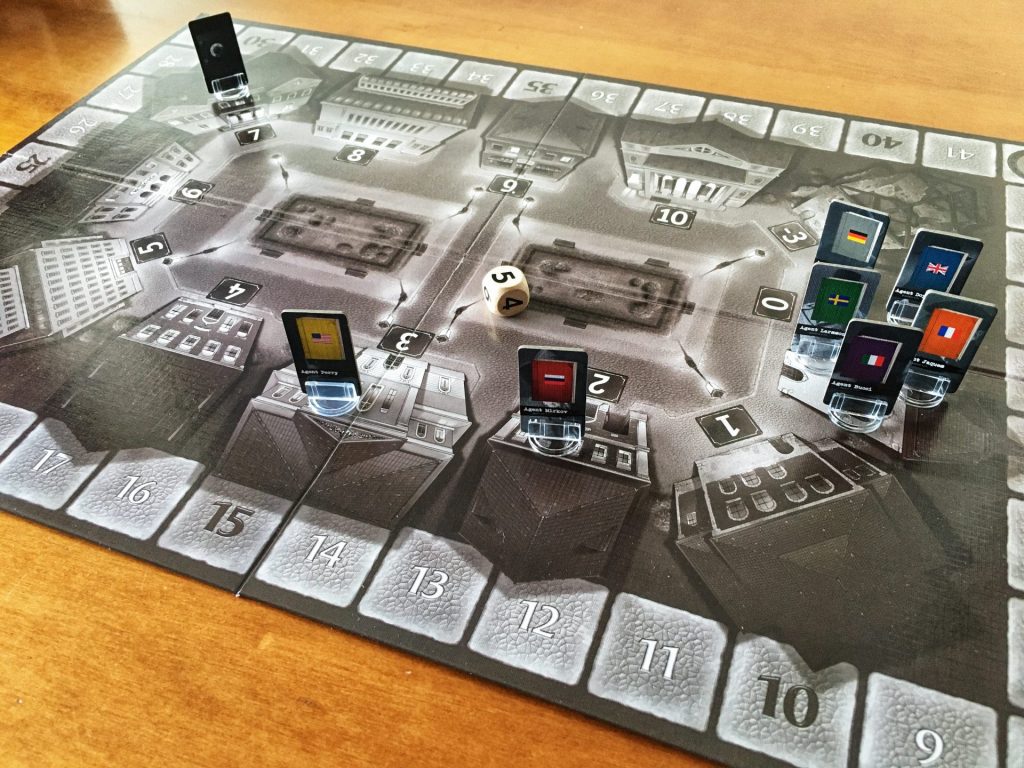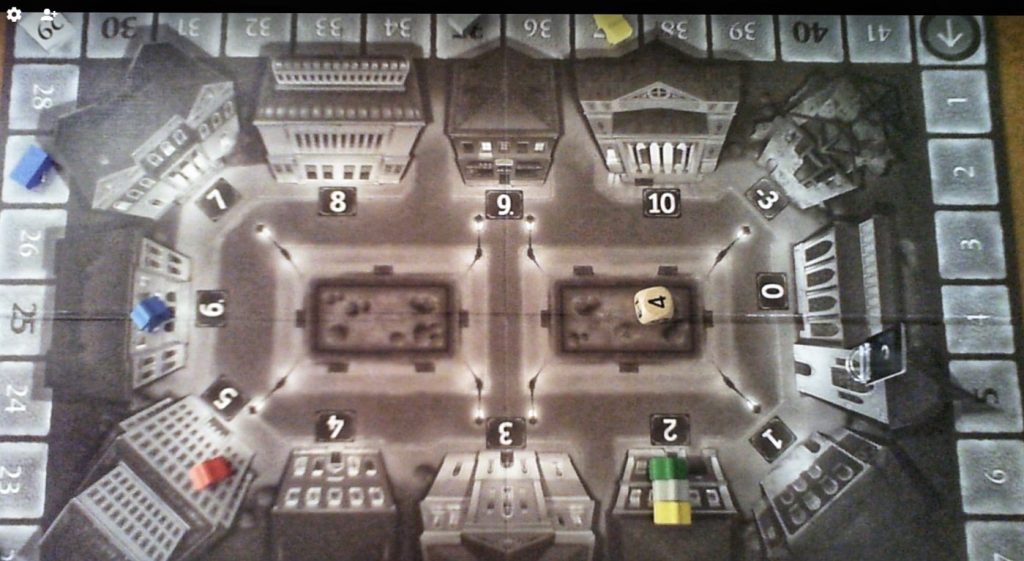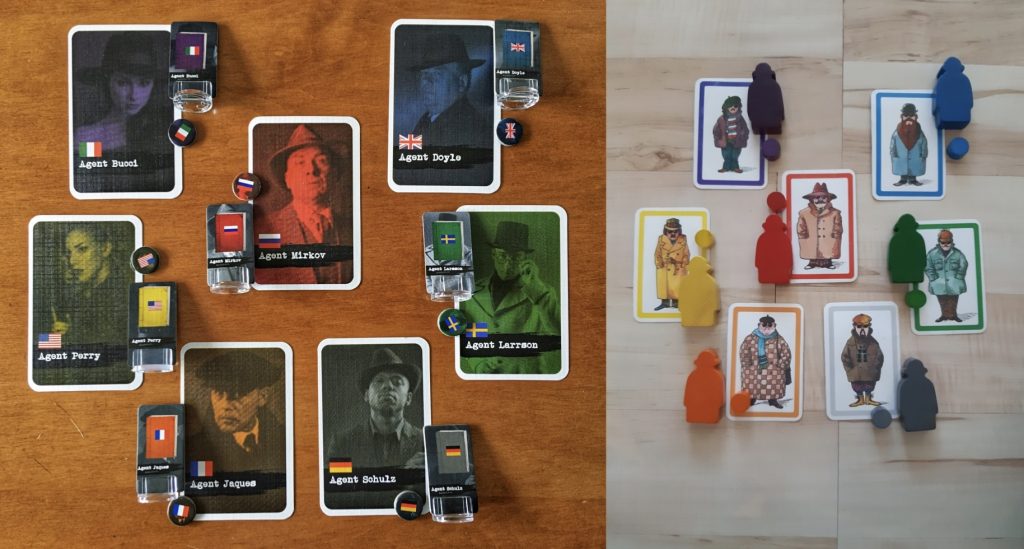In Heimlich & Co. players send their country’s best secret agent into the field to collect information hidden away in a safe. Thanks to fancy new gadgets, your team has narrowed down the location of the safe to a small, unremarkable town. Unfortunately, you’re not alone and other countries around the world have discovered the safe’s whereabouts and are sending their own agents as we speak. Now it’s up to you to gain the most information when the safe’s cracked and bring renown to your nation.
Did you know…I’m Smash and I drop in periodically in Ashley’s reviews?
In 1986, long before it made its way across the pond to North America, Heimlich & Co. won the Spiel des Jahres award. Since then it has continued to be a staple among board gamers getting into the hobby, especially as a way to introduce children to this wonderful world. (In fact, Meeple Mountain’s own Kathleen Hartin didn’t love Monopoly or Sorry! as a child; her favourite game was Heimlich & Co.)
Did you know…Other early Spiel des Jahres games that continue to thrive and be used to introduce young gamers to the world of gaming include: Scotland Yard, Labyrinth, Enchanted Forest, and Stop Thief.
So what is it about Heimlich & Co. that has given it staying power more than 30 years after its Spiel des Jahres win? Is it the thrilling spy theme, the roll-and-move mechanism, the bluffing and deduction necessary for players to do well, or the simplistic art and rules? Truthfully it is a combination of all of the above — even though many of these things don’t sound like winners on their own.
Let’s dive a little deeper into Heimlich & Co.’s gameplay and hopefully you too will see just why this game is so special.

Heimlich & Co. Gameplay
In Heimlich & Co., each player is assigned one of the Agents in the game. This is their secret identity. There are also a number of Agents in the game that are not assigned to a player; these are called “Free Agents”. The goal of the game is to have the most points and this is done by creating scoring situations throughout the game and ensuring that your Agent is in a position where they’ll score well. You need to be careful though because if players catch on to which Agent is yours, they can position them in such a way that they score very few — or even lose — points.
You begin your turn by rolling the die. The rolled value becomes the number of movement points you must use to move Agents clockwise around the board, from one building to the next. All Agents are fair game: you can move any Agent you would like and you can divide your movement points up between Agents as you wish (you may even use all your movement on a single Agent).
All Agents begin on Building 0, but once an Agent has made their way around the board to Building -3, they continue onto Building 0. In this way, there is no longer a ‘Start’ or ‘Finish’ space, just one big ol’ loop of buildings.

The Safe that players are trying to crack to gain information (points) throughout the game begins on Building 7. After using up all movement points, if one or more Agents end their movement on the building with the Safe, a “scoring situation” is created. All Agents score points relative to the number of the building they are on.

After this scoring, the player who created the scoring situation moves the Safe to a different building of their choice. This, however, does not cascade into another scoring situation if the Safe is placed on a building with Agents; an Agent must end their movement in the building with a Safe and not simply be present there.
Play then passes to the next player in turn order, who then rolls the die, moves Agents, and scores if a scoring situation is created. This order of play continues until at least one Agent’s scoring token reaches or passes the Finish space (the arrow, which is also used as the tokens’ starting space).
Then, each player reveals the secret identity on their Passport card and the player whose Agent scoring token progressed the furthest on the track wins the game. However, if the winning token matches one of the Free Agents, then no one wins.
Top Secret Expansions
This edition of Heimlich & Co. includes two expansions that can be added to the base game separately or together. The rules for each expansion simply add upon those of the base game.
Secret Identities
With this “expansion” (which is actually more a variant since it was included as part of the game’s original rules), players also earn points for correctly identifying to whom each Agent belongs. It adds even more incentive to bluff and be clever about disguising your secret identity. Once a scoring token reaches (or passes) space 29 on the scoring track, each player writes down to whom the Agents are assigned — this even includes if an Agent is a Free Agent (i.e., assigned to no one). At the end of the game, players earn an additional 5 points for each Agent they correctly identified.
Did you know… Heimlich & Co. is considered the first game to feature a victory point track around the edge of the gameboard, something that feels so ubiquitous in today’s board gaming world.
Top Secret Cards
This expansion adds a little more chaos to a game of Heimlich & Co. When a player rolls a ‘1-3’, they can choose not to move Agents and instead draw a Top Secret card. Additionally, when a player moves Agents to Building -3, they may draw a Top Secret card. All players have an opportunity to play as many Top Secret cards from their hands as they like before a scoring situation is evaluated. Top Secret cards range from moving Agents to moving the Safe to even moving scoring tokens.

Final Thoughts
I’ll admit that, as an adult, I’ve had some difficulty getting other adult gamers to play Heimlich & Co. if they’ve never heard of it before. When they first learn that it is a game in which you roll a die on your turn then move Agents around a board, they’re usually not impressed. It isn’t until I explain how the secret identities and scoring work that their eyes light up…and usually after a few turns, they’re hooked on the gameplay.
Did you know…Heimlich & Co. has been published under many names over the years (CIA, Detective & Co., Safe & Partners, Top Secret, Under Cover, and Top Secret Spies, to name a few.)
The brilliance of Heimlich & Co. is in how such a simple ruleset asks players to make difficult decisions on their turn by weighing the risks and rewards of these decisions.
Which Agents do I move and how many spaces? I don’t want to give my secret identity away, but I also can’t risk helping other players. I don’t want anyone to know that I think I know which Agent is theirs. I have the option to create a scoring situation, but my Agent isn’t positioned as well as I want it to be. I could wait, but that means another player might move my Agent into an even worse position. Is it worth the risk? Where will I move the Safe after a scoring situation?
Heimlich & Co. is all about the mind games; there are so many little things to consider in a game of Heimlich & Co. and with every move you make, you are risking giving away bits of information to your opponents.
Did you know…It’s easy to play Heimlich & Co. over video chat. (The picture below was taken from one of Ashley’s remote games.)

My favourite way to play Heimlich & Co. is to use the Secret Identities expansion rules; it’s a simple addition and deepens the gameplay, especially when you’re playing with adults. Conversely I don’t like playing with the Top Secret cards because they add too much randomness and chaos to a Euro-style game where I don’t feel like it belongs. That said, I could see kids who enjoy the frenetic energy in games like Sorry! and Mouse Trap appreciating this expansion.
In 2018 AMIGO freshened up Heimlich & Co. with a new modern look when it was brought over to North America for wider distribution thanks to AMIGO’s U.S gaming division. Overall I don’t mind the “retro” look, but I’m not a fan of the new Agent pieces — cardboard standees. I think the publisher might have made this choice to make the pieces a little easier to differentiate for players with colour blindness while also keeping the cost down, but this of course is purely speculation.

I also feel compelled to note the component quality overall is simply okay. Again with this modern rebranding, I would have loved to see the quality of the components improve from the earlier editions. I wouldn’t let it stop me from playing or owning the game, but I think it’s important to note so there are no expectations.
With these minor complaints aside, I see why Heimlich & Co. won the Spiel des Jahres award in 1986 and why it’s still loved and played more than 30 years later. While not everyone will appreciate Heimlich & Co.’s brilliance right off the bat, after one play they’ll most certainly change their tune.
Thematic Music for Playing Heimlich & Co.
From sneaky cartoon-esque spy music to the soundtrack from Alfred Hitchcock’s most famous spy movie to Mr. 007 himself, you’ll surely find some thematic music to your liking.












Looks like a beautiful game! Thanks for a great review.